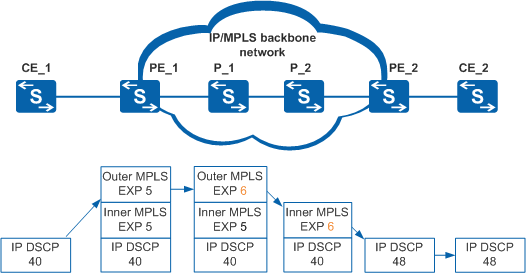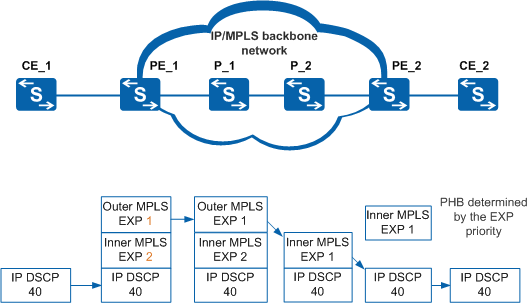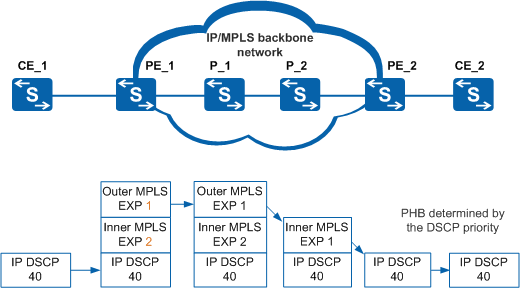MPLS DiffServ Tunnel Modes
Uniform: Packet priorities are uniformly defined on the IP network and the MPLS network, so the priorities are globally valid. On the ingress node, each packet is distributed a label and its DSCP or 802.1p priority is mapped to an EXP value. A change in the EXP value on the MPLS network determines the PHB used when the packet leaves the MPLS network. The egress node maps the EXP value to the DSCP or 802.1p priority. As an example, Figure 1 shows priority mapping in uniform mode on an L3VPN network.
P_1 changes the outer MPLS EXP value to 6. P_2 pops out the outer MPLS label and changes the inner MPLS EXP value to the outer MPLS EXP value. PE_2 changes the DSCP priority to 48.
Pipe: The EXP value can be manually configured, and the ingress node adds this EXP value to MPLS packets. Any change in the EXP value is valid only on the MPLS network. The egress node selects the PHB for MPLS packets according to the EXP value. When the packets leave the MPLS network, their DSCP or 802.1p priority is still valid. As an example, Figure 2 shows priority mapping in pipe mode on an L3VPN network.
PE_1 changes the outer and inner MPLS EXP values to 1 and 2. P_2 pops out the outer MPLS label and changes the inner MPLS EXP value to the outer MPLS EXP value. PE_2 retains the DSCP priority of packets and selects a PHB based on the inner MPLS EXP value.
Short pipe: The EXP value can be manually configured, and the ingress node adds this EXP value to MPLS packets. Any change in the EXP value is valid only on the MPLS network. The egress node selects the PHB for MPLS packets according to the DSCP or 802.1p priority. When the packets leave the MPLS network, their DSCP or 802.1p priority is still valid. As an example, Figure 3 shows priority mapping in short pipe mode on an L3VPN network.
PE_1 changes the outer and inner MPLS EXP values to 1 and 2. P_2 pops out the outer MPLS label and changes the inner MPLS EXP value to the outer MPLS EXP value. PE_2 retains the DSCP priority of packets and selects a PHB based on the DSCP priority.


